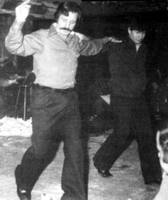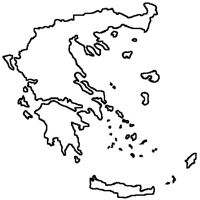
|
The Society of Folk Dance Historians (SFDH)
Significance of Dance
[
Home |
About |
Encyclopedia | CLICK AN IMAGE TO ENLARGE |

|

 The forceful way in which Greeks attack their cultural identity makes us realize the important role dance plays in their lives.
The forceful way in which Greeks attack their cultural identity makes us realize the important role dance plays in their lives.
It is no accident that their dance traditions are trace to their ancient heritage. From the earliest trends of development in their civilization, there was strong significance and dominance in the arts. Their attention to the expression of movement was inspiring and unique, and resulted in very specific forms of dance — initially in religious ceremonies, and later in secular activities. Dancing was one of the leading forces of expression. It maintained a stronghold in the hearts and feelings of the Greek people as a kind of insuring factor of their existing identity, and the imminence of their declining leadership as a world power.
The ensuing invaders who plowed through their landscape subjected them to domination, but they managed to retain their dances. This non-verbal means of communication was emphasized even more as a way of holding on to one's identity in the midst of the invader who, along with the subjugation, attempted to exercise foreign cultural influences. A question that hasa confused laymen and scholars for years is who truly imposed more influence — the conquered or the conqueror? The answer is simple when we can draw significant parallels in other forms of expression.
Language remained the same with only slight influences, and religion remained relevant. Thus, there is reason to believe that customs, traditions, folk tales, and folklore were constant. The dance can also be considered to have been consistent throughout history. Furthermore — and it may be one of the strongest clues we have about Greece and the Balkan countries — perhaps because of their domination during the great European renaissance, cultural influences were disseminating at a rapid pace and great changes and innovations were taking place.
The latter gave rise to the great Industrial Revolution while the Middle Eastern or Balkan peninsula nations remained divided from what became known as Western Europe. It is one reason why the tip of Eastern Europe is enjoying a belated renaissance and why the folk arts have been kept alive and bibrant in these countries. Culturally speaking, these nations are just now beginning to catch up to Western Europe.
In every society, dance plays an important role in depicting the temperament and environment of its people. For instance, after the rage of the ballroom era and dancing 'cheek to cheek', youth, always the forerunner of trends, broke loose into the 'twist.' 'Rock and roll' followed and then sheer abandonment of movement gave way to 'solo' type dancing. Now, or so-called 'solo' dancers are slowly beginning to reach for one another on the dance floor — touching (so to speak) again, relating to our times from doing 'our thing' to getting to know each other.
In Greece today, almost inadvertently the local traditions have been abandoned. Even in the villages, holding on to these ideas is considered old-fashioned, and most people are concerned with living up to the latest trends and fashions.
The growing interest of tourism in Greece, the advent of such films as "Never on Sunday" and "Zorba, the Greek" have had their impact, particularly outside Greek environs. The films created an interest in contemporary Greek culture an traditions, and in some cases certain notoriety resulted. But the outside world viewed these cinematic excursions as two rather vibrant and strong affirmations of life and considered them tremendous forces. Not only were they cinematic experiences, they began to influence aspects of culture.
Bouzouki music emerged out of its 'dens of iniquity' to share the spotlight with other major forms of music as entertainment. The celebrated Athenian, who was becoming a kind of European snob, and subject to British and French influences, and who was seeking entertainmet in the music halls, theaters, and nightclubs, began to turn the the bouzouki tavernas. Having to deal with the 'koutsavakia' or 'manghes' (and elite group considered underworld sub-culture), the Greek dance gained popularity with the upper and middle classes. The 'syrtaki' dances and the 'hasapiko' were exploited as an affectation rather than as a visible form of expression. Nevertheless, most of the greeks continued to keep their eyes on the Western world and to follow their trends.
However, outside of Greece there grew an awareness of Greek music and dancing in that if offered a feeling of abandonment. This form of line dancing, which had been restricted to the Greeks in the past, was accepted as a means of expression where people related to each other in a direct and meaningful manner. It gave them a feeling of belonging and being a part of a cultural heritage that had deep roots in history.
Greek immigrants in various parts of the world attempted to hold on to their Hellenism as well as their religion, language, and traditions. In the United States, in many instances, the first was a ghetto life which satisfied the emotional needs and gave a sense of security in the new world. But like all people, those who had been here for a couple of generations were losing touch with the past. Organizations, institutions, churches, festivals, and socials were established to maintain those traditions. Dances performed near the local church steps and in the recreation rooms resulted in magazine articles, short stories, novels, and films. The Greek in the United States had emerged to take his place among other cultures.
In his new home, the Greek strived to uphold his identity by passing on to his children the language, religion, customs, and folklore as well as the various dances. He was proud to see his children in his country's national dress and recapture a moment of past glory. Because he did not possess a coat of arms or could boast of being a descendant of a founding father dating back to Revolutionary times, he too, could show he was from a substantial background. Thus, he would endure to live side by side with his neighbor in the city or suburb.
DOCUMENTS
- Athan Karras, an article.
- Greece, a country.
Used with permission of the author.
This page © 2018 by Ron Houston.
Please do not copy any part of this page without including this copyright notice.
Please do not copy small portions out of context.
Please do not copy large portions without permission from Ron Houston.